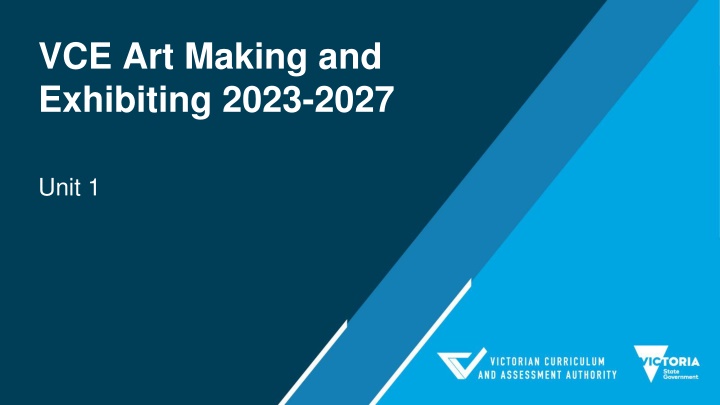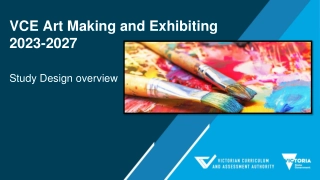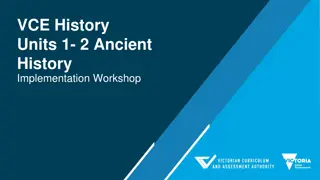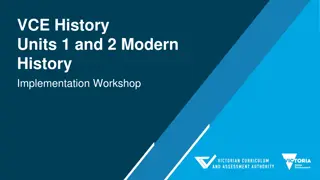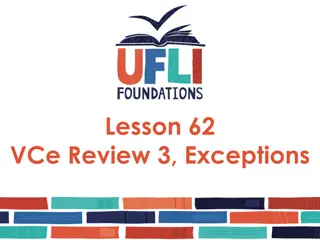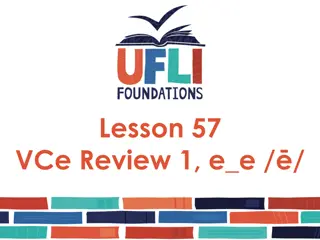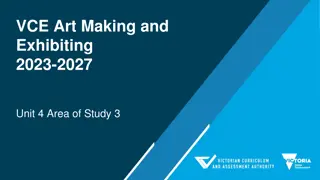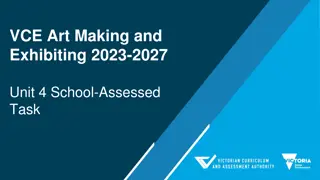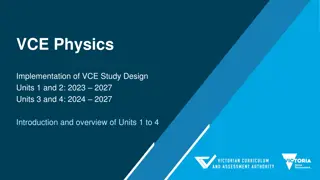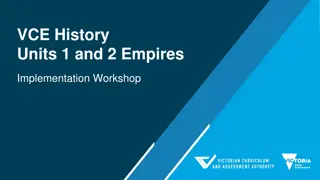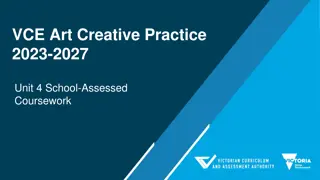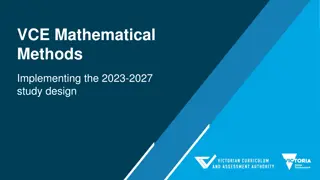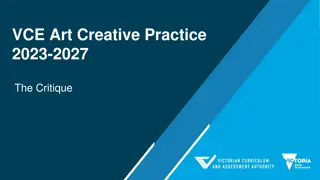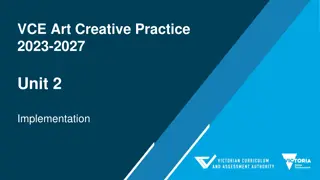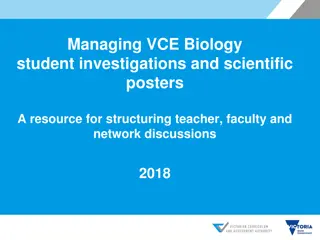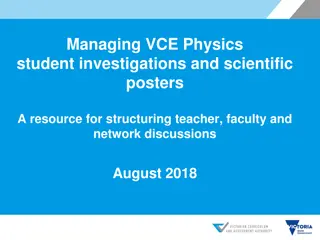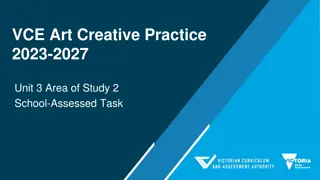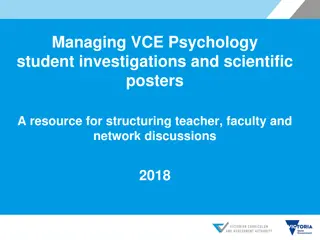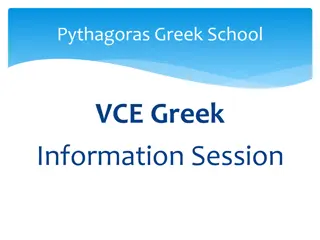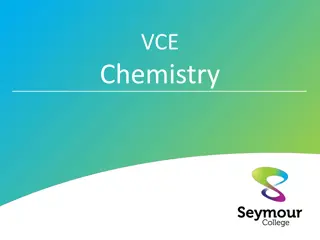VCE Art Making and Exhibiting Overview
This content provides a comprehensive outline of the VCE Art Making and Exhibiting 2023-2027 curriculum, including unit features, study specifications, and insights into making and exhibiting artworks. It covers various aspects such as art forms, influences, techniques, curation, exhibition design, conservation, and more.
Download Presentation

Please find below an Image/Link to download the presentation.
The content on the website is provided AS IS for your information and personal use only. It may not be sold, licensed, or shared on other websites without obtaining consent from the author.If you encounter any issues during the download, it is possible that the publisher has removed the file from their server.
You are allowed to download the files provided on this website for personal or commercial use, subject to the condition that they are used lawfully. All files are the property of their respective owners.
The content on the website is provided AS IS for your information and personal use only. It may not be sold, licensed, or shared on other websites without obtaining consent from the author.
E N D
Presentation Transcript
VCE Art Making and Exhibiting 2023-2027 Unit 1
VCE Art Making and Exhibiting Unit 1 Outline Features of Unit 1 Art Making and Exhibiting Overview of the areas of study Teaching ideas Assessment ideas
VCE Art Making and Exhibiting Study specifications Explore Expand Investigate Understand Develop Resolve Collect Extend Connect Consolidate Present Conserve
VCE Art Making and Exhibiting Study specifications: Making artworks Explore Expand Investigate Understand Develop Resolve Collect Extend Connect Consolidate Present Conserve Artforms Influences and inspiration Techniques Ideas and meaning Processes Making artworks Visual Language Materials Art elements and Art Principles Aesthetic qualities
VCE Art Making and Exhibiting Study specifications: Exhibiting artworks Planning and producing the layout and design of the exhibition and planning the flow of the exhibition, including sight lines, spatial relationships, viewer interaction and interpretation. Includes the creation of display furniture, selection of fixtures and use of lighting. Exhibition design Determining the theme or story to be told in an exhibition. Curation includes the selection of artworks, writing the introduction to the exhibition, deciding where artworks will be placed, the designing of viewer interaction and interpretation, and the preparation of condition reports of artworks. Curation Planning, organising and undertaking the preservation and conservation of materials and objects in private, public and community collections, including art galleries, museums, other exhibition spaces and site-specific spaces. Conservation
VCE Art Making and Exhibiting Study specifications: Exhibiting artworks Explore Expand Investigate Understand Develop Resolve Collect Extend Connect Consolidate Present Conserve Museums Exhibition design Galleries Curation Other exhibition spaces Conservation Site specific spaces
VCE Art Making and Exhibiting Study specifications: Study Terms Art elements Art principles Art forms Contexts Critique Influences and inspiration Visual language Aesthetic qualities
VCE Art Making and Exhibiting Unit 1: Explore, expand and investigate Exploration of materials, techniques and processes in specific art forms Study of the historical development of art forms and the change in characteristics and properties Exploration of how artists use materials, techniques and processes to stimulate ideas and working practices in a range of art forms Presentation of artworks and research with a focus on exhibitions Area of Study Inquiry focus Area of Study 1 Explore - materials, techniques and art forms How do artists use materials and techniques in their art making? Area of Study 2 Expand - make, present and reflect How do artists use materials and techniques to represent ideas and achieve a style in their artworks? Area of Study 3 Investigate - research and present What role do artworks and their presentation play in society?
VCE Art Making and Exhibiting Unit 1: Explore, expand and investigate Area of Study Outcome On completion of this unit the student should be able to explore the characteristics and properties of materials and demonstrate how they can be manipulated to develop subject matter and represent ideas in art making. Area of Study 1 Explore - materials, techniques and art forms On completion of this unit the student should be able to make and present at least one finished artwork and document their art making in a Visual Arts journal. Area of Study 2 Expand - make, present and reflect On completion of this unit the student should be able to research Australian artists and present information about them in a format appropriate for a proposed exhibition. Area of Study 3 Investigate - research and present
VCE Art Making and Exhibiting Unit 1 Big Planning Ideas What art forms do you want to teach? What exhibition spaces would you like to study What are the ideas/themes you would like to teach? How can you weave these themes/ideas throughout your course? Student choice: is there an opportunity for you to tailor a course based on student choice? What will be the following unit 3 and 4? How will you approach the school-assessed Task? What would you like to retain? What would you like to change? What excites you about this Study Design?
VCE Art Making and Exhibiting Unit 1 Area of Study 1 - Explore - materials, techniques and art forms On completion of this unit the student should be able to explore the characteristics and properties of materials and demonstrate how they can be manipulated to develop subject matter and represent ideas in art making. Outcome 1 How do artists use materials and techniques in their art making? How do I experiment with materials, techniques and processes? What are the different art forms I want to look at? How do artists use visual language? How do I create a relationship between the materials, techniques and processes I use and the representation of subject matter? How do I make connections between my research and art making? How will I document and record my findings? What is included in the Visual Arts Journal? Learning structure
VCE Art Making and Exhibiting Unit 1 Area of Study 1: Explore Materials, techniques and art forms Key knowledge the use of materials, techniques and processes in the historical development of art forms the inherent characteristics and properties of materials understanding of technical skills when using materials and techniques in art making the manipulation of materials and use of techniques to develop subject matter and represent ideas in art making the use of materials and techniques to develop visual language in art making methods used to document and organise written and visual reference materials the use of visual language and art terminology to reflect on and document art making
VCE Art Making and Exhibiting Unit 1 Area of Study 1: Explore Materials, techniques and art forms investigate the use of materials, techniques and processes in the historical development of specific art forms investigate the characteristics and properties of materials in art making in specific art forms develop and apply technical skills when using materials and techniques in art making in specific art forms explore how materials can be manipulated to develop subject matter and represent ideas in art making research how artists manipulate materials to develop subject matter and represent ideas in art making explore materials and techniques to develop visual language in art making progressively document the development of art making in a Visual Arts journal use visual language and art terminology to reflect on and document art making Key skills
VCE Art Making and Exhibiting Unit 1 Area of Study 1 Teaching and Learning Ideas Teacher led exploration of a range of artforms Universal theme. For example, memory, family, the environment, belonging and acceptance, friendship, communication, mortality Looking at the history, characteristics and properties of materials Play Generating subject matter related to the theme Representing ideas related to the theme Learning about documenting the visual art journal Investigating artists and artworks that use a range practices. Experiences in a range of artforms for example drawing and printmaking or drawing and painting, drawing and ceramics, or drawing and photography. Investigation of three art forms What are the key technological stages in the evolution of the artform? Connect to artworks that will represent technological developments Analyse the work of other artists who use different processes and analyse their own art making. The same artists could be related to work completed in Outcome 3
VCE Art Making and Exhibiting Unit 1 Area of Study 1 Detailed learning example Art Form Research Project Select an art form to use as a guide to research and write an introduction about the art form. Answer the following questions: What is the art form? Why does it interest you? What is your experience with the art form? Collect 3 5 visual examples of the art form that represent its development from historical to contemporary times. Choose a further three examples of the art form from a specific period in time and analyse the use of materials and techniques Create a list of the correct terminology related to the art form and its associated materials, techniques and processes Choose two techniques used by artists in the art form and explore using those techniques Evaluate your experiments in your Visual Arts journal.
VCE Art Making and Exhibiting Unit 1 Area of Study 1 Assessment Visual Arts journal Examples such as: Research activities in specific artforms A range of experiments in specific art forms Documentation in the Visual Arts journal Students record and document art making in the Visual Arts journal using written and visual material. The Visual Arts journal includes: demonstration of the exploration of materials, techniques and processes, in a range of art forms demonstration of technical skill in using materials in a range of art forms documentation and evaluation of the exploration of materials, techniques and processes in a range of art forms.
VCE Art Making and Exhibiting Unit 1 Area of Study 1 Assessment Example Art Form Research In your Visual Arts Journal, research into a range of art forms. Investigate the history of the materials used within the art forms. Discuss and consider the following questions: o Where are the earliest examples of the art forms and across varying contexts? o How have the characteristics and or the properties changed within the contexts? Has the influence of technology altered the material? Produce a series of experiments using a selected artform and techniques in response to the research. Write an evaluation of how the experiment reflects a particular technique you have studied.
VCE Art Making and Exhibiting Unit 1 Area of Study 2: Expand make, present and reflect On completion of this unit the student should be able to make and present at least one finished artwork and document their art making in a Visual Arts journal. Outcome 2 How do artists use materials and techniques to represent ideas and achieve a style in their artworks? What art form will I focus upon? Which artists will I investigate? What materials, techniques and processes do they use? How will I develop my subject matter to represent ideas? How do I use visual language to represent ideas? How will I present my finished artwork? How will I document and evaluate my art making? Learning structure
VCE Art Making and Exhibiting Unit 1 Area of Study 2: Expand make, present and reflect Key knowledge the use of materials, techniques and processes used to make artworks in specific art forms characteristics and properties of materials in finished artworks in specific art forms techniques used to develop subject matter and represent ideas in finished artworks the use of visual language in finished artworks methods used to document the making of finished artworks in a Visual Arts journal methods used to present and evaluate finished artworks visual language and art terminology used to record and evaluate the making and presentation of artworks in specific art forms
VCE Art Making and Exhibiting Unit 1 Area of Study 2: Expand make, present and reflect Key skills at least one finished artwork in a specific art form explore the application of a variety of techniques to represent ideas in at least one finished artwork in a specific art form develop subject matter in at least one finished artwork in a specific art form use visual language to communicate ideas in at least one finished artwork progressively reflect, evaluate and document in their Visual Arts journal the use of materials, techniques and processes to develop at least one finished artwork present and evaluate at least one finished artwork in a specific art form use visual language and art terminology to record and evaluate the making and presentation of at least one finished artwork in a specific art form explore and evaluate the materials, techniques and processes used to make
VCE Art Making and Exhibiting Unit 1 Area of Study 2 Teaching and Learning Ideas At least one artwork that responds to the investigation of materials and experimentations in Area of Study 1. Artist's statement about art making (could be in the form of a didactic panel - 100 words) Reflection statement about art making experience (3 - 4 paragraphs that might consolidate gaps in their annotations or extract key moments of learning from the visual arts journal Recognise the difference between a reflection and an artist statement - excellent learning opportunities for the critique in units 3 and 4 At the end of Area of Study 2, students must submit at least one artwork, the reflection and artist s statement.
VCE Art Making and Exhibiting Unit 1 Area of Study 2 Detailed learning example Reflection Statement and Artist Statement In the Visual Arts Journal, write a reflective evaluation on the art making experience: An Artist Statement is a concise description of the context of the ideas and meanings of the artwork. It could be presented as a didactic panel. Write a short artists statement to accompany the presented artwork. This statement provides context and insight in relation to the final artwork and the approach taken to the set theme. Consider how the materials and techniques connect to the ideas and meaning? How is visual language representing individual ideas on the theme? A Reflection Statement needs to utilise critical thinking skills to evaluate the art making. Refer to the researched terminology from AOS1 to include into your evaluation of the making and presentation of the final artwork
VCE Art Making and Exhibiting Unit 1 Area of Study 2 Assessment On completion of the unit the student should be able to make and present at least one finished artwork and document their art making in a Visual Arts journal. Examples such as: Application of materials and techniques to represent ideas At least one finished artwork Documentation and evaluation in the Visual Arts journal The finished artwork demonstrates: the use of materials and techniques in a specific art form the development of skills in specific art forms how techniques have been used to represent ideas in at least one finished artwork in a specific art form.
VCE Art Making and Exhibiting Unit 1 Area of Study 2 Assessment Example Finished Artwork and documentation Has at least one finished artwork from the experimental works completed in Area of Study 1 been developed? The finished artwork and Visual Arts journal should include: the use of materials and techniques in a specific art form explored in Area of Study 1 the development of skills in specific art forms in the Visual Arts journal and at least one finished artwork techniques have been used to represent ideas in at least one finished artwork in a specific art form documentation of written and visual material in the Visual Arts journal demonstrating reflection and evaluation of the development and refinement of the finished artwork. a statement discussing the representation of ideas and reflecting on the art making process
VCE Art Making and Exhibiting Unit 1 Area of Study 3: Investigate research and present On completion of this unit the student should be able to research Australian artists and present information about them in a format appropriate for a proposed exhibition. What role do artworks and their presentation play in society? Which artists will I research? How does context influence the materials, techniques and processes the artist uses? How do artists represent ideas and communicate meaning in artworks? How are artworks presented to communicate the artist s intention to an audience? How is information about an exhibition organised and presented? Outcome 3 Learning structure
VCE Art Making and Exhibiting Unit 1 Area of Study 3 The research for the information is documented in the student s Visual Arts journal. In their presentation of research students: select three artists, including one or more Aboriginal or Torres Strait Islander artists, and at least one artwork by each artist provide information and an overview of each artist, including background information and the influences on their art making, including where the artist was born, lives/lived and works/worked provide an overview of the artists and their works selected for exhibition explore how each artist has applied materials, techniques and processes to make each artwork explain how artists represent ideas and use subject matter to communicate meaning in each artwork.
VCE Art Making and Exhibiting Unit 1 Area of Study 3: Investigate research and present the influence of context on the practices of Australian artists and their artworks characteristics and properties of materials used by artists to make artworks ways in which artists apply materials in the making of artworks ways in which artists use techniques and processes to make artworks how artists represent ideas and use subject matter to communicate meaning in artworks strategies used to create a cohesive presentation about artists and their artworks ways to discuss artworks and art forms on display strategies used to prepare information for the exhibition of artworks appropriate terminology used to discuss artworks and exhibitions Key knowledge
VCE Art Making and Exhibiting Unit 1 Area of Study 3: Investigate research and present Key skills artworks use a range of resources to research how artists have used materials, techniques and processes in the making of their artworks explain and evaluate how artists have used materials, techniques and processes to make artworks analyse how artists represent ideas and use subject matter to communicate meaning in their artworks use a variety of methods and strategies to present information for a proposed exhibition of artworks by Australian artists develop and present information discussing a range of artworks by Australian artists use appropriate terminology in the discussion of artworks and their presentation explore and discuss the contexts of a range of Australian artists and their
VCE Art Making and Exhibiting Unit 1 Area of Study 3 Presentation The presentation includes: an artwork by each artist with the title, date, materials, current location and size information and overview of each artist, including the artist s background, where they work/worked and influences information and overview of the exhibition of the artworks, discussing the relationships between the artists and their artworks information about the materials, techniques and processes used for each artwork information about how each artist applies materials, techniques and processes in the artworks information about how each artist represents ideas, develops subject matter and communicates meaning in their artworks art terminology relevant to specific art forms and for the exhibition of artworks.
VCE Art Making and Exhibiting Unit 1 Area of Study 3 Teaching and Learning Ideas The students are writing about the following: Background of the artist Influences on their artmaking Overview - the connection and relationship between the selected artists and artworks Application of materials, techniques and processes Representation of ideas and use of subject matter to communicate meaning in each artwork. Schools should refer to the Art Making and Exhibiting Exhibitions list that will be published annually for further information and advice. Schools may also choose to visit online exhibitions to address both outcomes. This research could be presented as a set of didactic panels. Schools are encouraged to visit an exhibition where students can see the context where potential selected artworks have been exhibited. It will also then allow students with greater insights This is an opportunity for class discussions about the global context of artmaking and the rapidly changing environment artist live and work within. o o o o o
VCE Art Making and Exhibiting Unit 1 Area of Study 3 Detailed learning example Visit the selected exhibition/ art collection to view and investigate a selection of at least three artworks by three Australian artists, including at least one First Nations Australian artist. When viewing the artworks explore and research: how each of the three artists has applied materials, techniques, and processes to make their artworks how each of the three artists has expressed ideas and meanings within their artworks how cultural, historical, and social contexts have influenced each of the artists and their artworks how each of the three artworks is displayed and the reason/s why this kind of approach is appropriate with respect to the art form and meaning of the artwork examples of texts, publications, programs and promotions produced for audiences in association with the exhibition/collection
VCE Art Making and Exhibiting Unit 1 Area of Study 3 Assessment On completion of this unit the student should be able to research Australian artists and present information about them in a format appropriate for a proposed exhibition. Presentation formats could include: o Podcast/Vodcast o Instagram posts o Didactic panels o Postcards o A review of the exhibition Information for an exhibition Students present information about three Australian artists, including at least one Aboriginal or Torres Strait Islander artist, and at least one artwork by each artist in one of the following formats: a guided introduction to the works in a brochure or catalogue or on a website a guided tour of the exhibition a series of postcards discussing each artwork a review of an exhibition visited or viewed.
VCE Art Making and Exhibiting Unit 1 Area of Study 3 Assessment Example The research of Australian artists is documented in the Visual Arts journal and a presentation of information is created in a format appropriate for a proposed exhibition: explore and discuss the contexts of a range of Australian artists and their artworks use a range of resources to research how artists have used materials, techniques and processes in the making of their artworks explain and evaluate how artists have used materials, techniques and processes to make artworks analyse how artists represent ideas and use subject matter to communicate meaning in their artworks use a variety of methods and strategies to present information for a proposed exhibition of artworks by Australian artists
Contact Dr Kathryn Hendy-Ekers Curriculum Manager Visual Arts, Visual Communication Design and Media E: Kathryn.Hendy-Ekers@education.vic.gov.au T: 9059 5147 M: 0438471513
